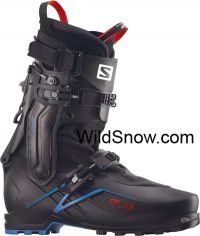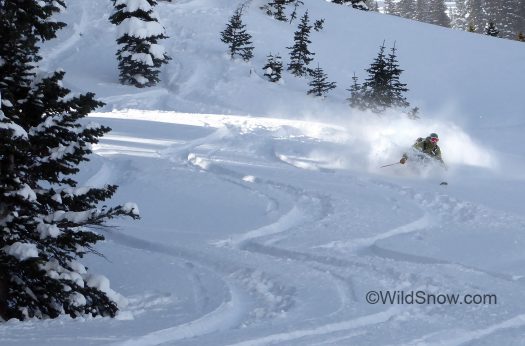
Both Atomic and Salomon are all-in with full human powered ski touring, their Procline-X-Alp form factor proves it. Click images to enlarge.
1. With seemingly endless improvements in the “one kilo” class boots designed for ski touring, it’s obvious that despite industry hope that “freeride!” touring would open up a population of new customers, roots are roots. Witness, after years of attempting to define their idea of consumer segments, Dynafit is innovating (and branding) with a totally new “fitness” category (referring to activities such as uphilling at resorts). Or consider Salomon, La Sportiva and others who are clearly going after this segment of the market. More about that as the trade show season progresses.
Trend: Narrower skis are back in style for human powered skiing, what with planks such as Volkl VTA 88 Lite being so fine.
2. Is the era of ski writer “fams” coming to an end? Not sure about that, as I just returned from a nice Salomon press event held here in Colorado.
But, hear that noise? Is that the fabric of the universe tearing? We’ve based much of our content here at WildSnow.com on nearly a decade of European ski touring trips, usually layered on top of the annual Dynafit press event held at various classic ski touring venues in the Alps (and last winter in Greece). This time, Dynafit scheduled and then canceled their 2017 press event. Ostensibly because they wanted to introduce their new fitness category (see above) and lacked product samples, but I suspect there may have been other reasons.
Presently, I’m still planning on my annual trip to the old country, but I’ll have to arrange my own industry visits. I’ll hit ISPO of course, and perhaps take that nice train ride again to the Val di Fiemme and La Sportiva. Dropping in to see Dynafit near Munich is probably a given as well. Stay tuned.
3. Ebikes. Yes, ebikes. In many of North America’s mountain areas mechanized access using automobiles or God forbid snowmobiles is considered the ultimate sin, while if you have the time or fitness for extra walking (or money for a horse), you are allowed in. Don’t get me wrong, I like that we’ve got legal Wilderness, but in my opinion much of our non-Wilderness public land is unfairly difficult to reach. Closed yet navigable roads are one of the worst offenders. Perhaps the solution is the electric bicycle.
Pedal assist “pedelec” type are not motorcycles, they’re a hybrid transportation machine in a class of their own. In my opinion, pedelecs are the perfect way to handle gated roads and other products resulting from the “lock out that pesky public” ‘tude we’ve been battling for years. So, my predication? Ebikes will become ubiquitous, more so as grocery getters, but as tools of alpine recreation as well.
Now, before you get your Capilene bikini briefs in a bunch, I’m 100% onboard with ebikes requiring care so their use doesn’t piss off land managers to the point of interfering with the stupendous build-out of mountain bike trails we’ve seen in the past few decades. That said, we’d like to see a few of such trails where pedelec ebikes are legal; I predict that’ll happen.
Check out this excellent ebike article.
4. Avalanche airbag backpacks beg for prognostication. Despite my being lectured literally dozens of times that “weight doesn’t matter so much to consumers when it comes to safety gear” I predict that winners of the balloon pack weight games will rule the market. At this time, that’s clearly Mammut with their re-worked plumbing paired with carbon cartridge. Look for this to continue. Areas still to be improved? Balloons made with lighter fabrics, 30 or more liter backpacks with minimalist design philosophy (roll top and no zipper, anyone?). Oh, and about those electric fan packs we’ve been so excited about? I’m embarrassed to say that my unbridled enthusiasm seems to be diminished. I could probably make a balloon pack myself that wasn’t any heavier than the commercial electronics, using a Bosch cordless vacuum wired to a toggle switch on my pack strap.
5. So, out of the “big three” boots, bindings, skis we talked about boots above. Obviously, in the world of ski touring bindings two major things are happening.
Firstly, engineers have figured out ways to combine “alpine like” vertical heel elastic travel with the use of what are now the defacto standard “tech” fittings built into so many boot models we lost count years ago. Examples, see Marker and Fritschi.
Of equal importance in the binding arena, the ultra-minimalist tech binding design invented by Fritz Barthel is not going away — only being incrementally improved. Good examples are the Atomic-Salomon Backland-MTN offering, Dynafit Superlite 2.0. and of course the ATK jewelry that Giovani comes up with every year. These types of bindings have been shown by engineers to lack safety release at certain angles, and may have problems with accidental release when used at “normal” release tension settings, nonetheless literally millions of happy ski tourers have proved that they work. Key is experimenting with how the binding is set up, as well as pairing your equipment configuration to your ski style. The future will bring the simplicity of the original Barthel binding paired with better safety and retention performance.
6. Telemark skiing will not die. What’s different, however, is the days are over when industry propaganda and media hacks did a pretty good job of convincing nearly every North American backcountry skier that they had to telemark in order to ski tour — even if they had to endure linked falls instead of linked turns.
Now, telemark skiing has become what I always thought it should be: A fun way of turning a ski for talented athletes who want to do it that way, and do it well (was just out with a couple of good tele skiers several days ago, as a matter of fact). Thus, I predict that telemark bindings will not go away, but sadly, that getting decent telemark ski touring boots will become ever more difficult. Reason, telemark bindings are fairly easy and less costly to manufacture compared to injection molded ski footwear. Bindings are also easier to warranty support; you just keep a few bins of parts kicking around. Boots, if the plastic cracks or something equally as hideous, you’re sending out whole new pairs and chipping the rejects. Hard to make that financially viable in what’s obviously a small market.
7. Heated footwear will come into its own this coming year, what with lighter less bulky batteries and better control systems. Look for systems that don’t involve failure prone wires and are controlled wirelessly using a dedicated fob or your smartphone. Like this. I have to wonder if instead of the common design philosophy involving heated insoles, a well made heated sock might be a better option? These guys are an example. We should probably ramp up our blogging about this stuff, as both Lisa and I could stand to use these products.
8. I just heard from an iPhone 7 user (and WildSnow reader) who tells me that Apple is now providing a screen that’s much easier to read in bright light, along with a battery that actually lasts. Prediction, look for an upsurge in the already popular but sometimes difficult pairing of GPS app with smartphone hardware. Also, as with most mainstream smartphones you can already get auxiliary batteries for the 7, which will pretty much eliminate capacity issues for extended backcountry use. Example here. Me, I’m still using my cheapo (bought used) Samsung Galaxy Note 3 with a huge aftermarket battery. It works great — other than the screen not being good outdoors. Perhaps it’s finally time for an iPhone?
9. On the clothing front, look for wool to continue as a magic ingredient. Water resistant down as well. A trend will be (or has been for some time) the use of ultra-light shells such as Strafe Scout jacket, combined with a down puffy, fleece hoody and wool baselayers. Super versatile, though you’d want to switch shells to something more bullet proof (and insulation to Primaloft) if you’re on lengthy tours in full wet conditions.
10. Lastly, climate change, relating to batteries, and batteries relating to backcountry skiing…
It’s been annoying to read media hypsters stating things such as “solar now cheaper than coal!” Apparently, ignorant “reporters” for some reason have jumped on this fake news like a bunch of seagulls on chum. Fact is, when figuring the true cost of solar you have to include the cost of storage — a much more complicated equation. For example, our tiny house WildSnow Field HQ has a nice PV system — but to be practical we need at least $1,000 worth of batteries that’ll last at the most for ~6 years and much less if they’re aggressively used (they wear out fast if drained down regularly). Utility scale storage is cheaper, but not exactly inexpensive.
So, my optimistic predictions regarding PV are twofold. First, I’d expect at some time in the next 12 months a more cost effective battery technology will be industrialized (the science is already there). Even a 20% reduction in total cost would be a huge deal. Second, it seems to me that wind power makes a lot of sense and we’ll see much more of it — thus perhaps slowing down global warming. (Though as we’ve stated many times, it’s our belief that the only way GW will be significantly changed is by climate engineering — expect to see debate about that in coming months.)
Swinging back to ski touring, significantly lighter batteries for a given energy density will change everything from how big your headlamp is, to making the electronic airbag packs weight competitive. That’ll be fun. But will they be any less expensive per kilowatt-hour?
WildSnow.com publisher emeritus and founder Lou (Louis Dawson) has a 50+ years career in climbing, backcountry skiing and ski mountaineering. He was the first person in history to ski down all 54 Colorado 14,000-foot peaks, has authored numerous books about about backcountry skiing, and has skied from the summit of Denali in Alaska, North America’s highest mountain.

